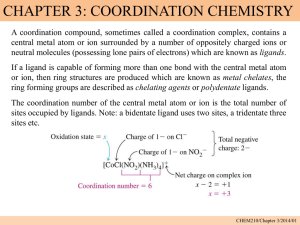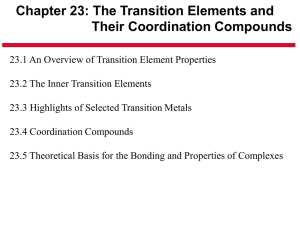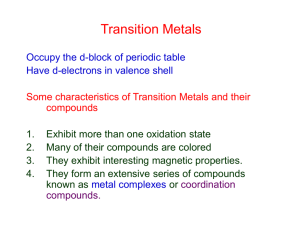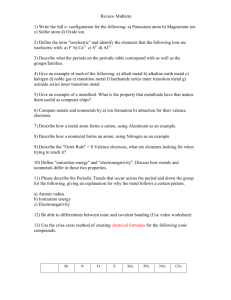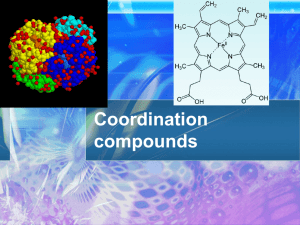coordination compound
advertisement
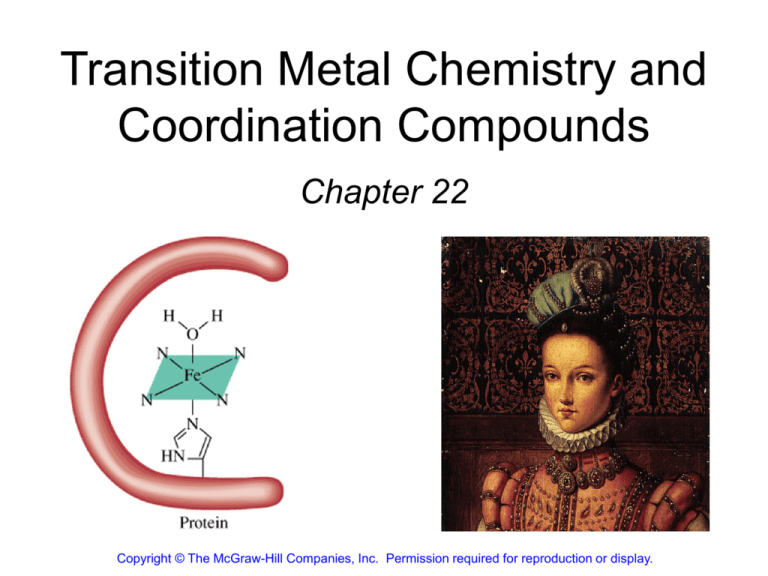
Transition Metal Chemistry and Coordination Compounds Chapter 22 Copyright © The McGraw-Hill Companies, Inc. Permission required for reproduction or display. The Transition Metals 22.1 22.1 22.1 Oxidation States of the 1st Row Transition Metals (most stable oxidation numbers are shown in red) 22.1 Ionization Energies for the 1st Row Transition Metals 22.1 Scandium Titanium Vanadium Chromium Manganese Iron Cobalt Nickel Copper 22.2 Coordination Compounds A coordination compound typically consists of a complex ion and a counter ion. A complex ion contains a central metal cation bonded to one or more molecules or ions. The molecules or ions that surround the metal in a complex ion are called ligands. H H H H H •• Cl •• - C •• O •• •• •• N •• A ligand has at least one unshared pair of valence electrons O 22.3 Coordination Compounds The atom in a ligand that is bound directly to the metal atom is the donor atom. •• N O H H H H H The number of donor atoms surrounding the central metal atom in a complex ion is the coordination number. Ligands with: one donor atom two donor atoms three or more donor atoms monodentate bidentate H2O, NH3, Clethylenediamine polydentate EDTA 22.3 Coordination Compounds bidentate ligand •• H2N CH2 CH2 •• NH2 polydentate ligand (EDTA) Bidentate and polydentate ligands are called chelating agents 22.3 22.3 What are the oxidation numbers of the metals in K[Au(OH)4] and [Cr(NH3)6](NO3)3 ? OH- has charge of -1 K+ has charge of +1 ? Au + 1 + 4x(-1) = 0 Au = +3 NO3- has charge of -1 NH3 has no charge ? Cr + 6x(0) + 3x(-1) = 0 Cr = +3 22.3 Naming Coordination Compounds • The cation is named before the anion. • Within a complex ion, the ligands are named first in alphabetical order and the metal atom is named last. • The names of anionic ligands end with the letter o. Neutral ligands are usually called by the name of the molecule. The exceptions are H2O (aquo), CO (carbonyl), and NH3 (ammine). • When several ligands of a particular kind are present, the Greek prefixes di-, tri-, tetra-, penta-, and hexa- are used to indicate the number. If the ligand contains a Greek prefix, use the prefixes bis, tris, and tetrakis to indicate the number. • The oxidation number of the metal is written in Roman numerals following the name of the metal. • If the complex is an anion, its name ends in –ate. 22.3 22.3 What is the systematic name of [Cr(H2O)4Cl2]Cl ? tetraaquodichlorochromium(III) chloride Write the formula of tris(ethylenediamine)cobalt(II) sulfate [Co(en)3]SO4 22.3 Structure of Coordination Compounds Coordination number 2 Structure Linear 4 Tetrahedral or Square planar 6 Octahedral 22.4 Structure of Coordination Compounds Stereoisomers are compounds that are made up of the same types and numbers of atoms bonded together in the same sequence but with different spatial arrangements. Geometric isomers are stereoisomers that cannot be interconverted without breaking a chemical bond. cis-[Pt(NH3)2Cl2] trans-[Pt(NH3)2Cl2] 22.4 Structure of Coordination Compounds trans cis cis-[Co(NH3)4Cl2] trans-[Co(NH3)4Cl2] Are these additional geometric isomers of [Co(NH3)4Cl2]? 22.4 Structure of Coordination Compounds Optical isomers are nonsuperimposable mirror images. cis-[Co(en)2Cl2] trans-[Co(en)2Cl2] optical isomers not optical isomers chiral achiral 22.4 Structure of Coordination Compounds Chiral molecules are optically active. 22.4 Bonding in Coordination Compounds All equal in energy in the absence of ligands! 22.5 Bonding in Coordination Compounds Isolated transition metal atom Bonded transition metal atom Crystal field splitting ( D) is the energy difference between two sets of d orbitals in a metal atom when ligands are present 22.5 Bonding in Coordination Compounds D = hn 22.5 The absorption maximum for the complex ion [Co(NH3)6]3+ occurs at 470 nm. What is the color of the complex and what is the crystal field splitting in kJ/mol? Absorbs blue, will appear orange. hc (6.63 x 10-34 J s) x (3.00 x 108 m s-1) D = hn = = = 4.23 x 10-19 J l 470 x 10-9 m D (kJ/mol) = 4.23 x 10-19 J/atom x 6.022 x 1023 atoms/mol = 255 kJ/mol 22.5 Bonding in Coordination Compounds Spectrochemical Series I- < Br- < Cl- < OH- < F- < H2O < NH3 < en < CN- < CO Weak field ligands Small D Strong field ligands Large D 22.5 Bonding in Coordination Compounds 22.5
